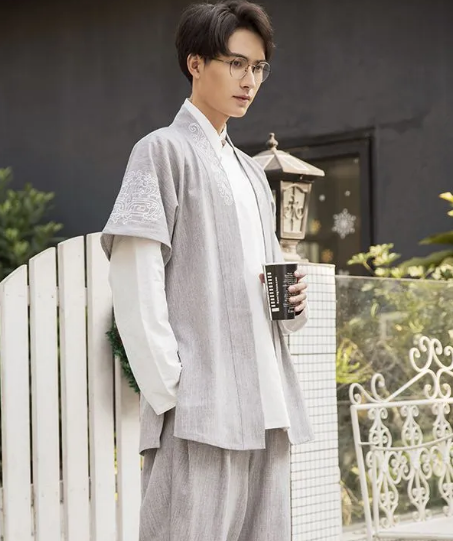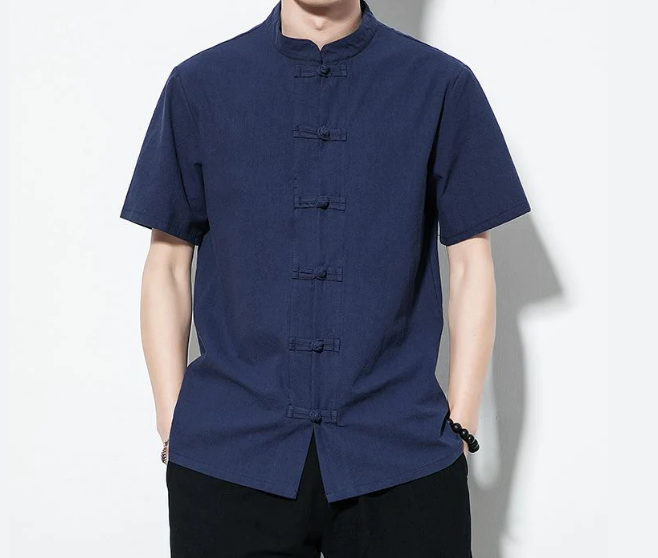Historical Significance
Origin and Evolution
Tang suits trace their roots to the Tang Dynasty, a period that often marks the zenith of cosmopolitan culture in China. The clothing style draws inspiration from the robes worn by the scholarly elite and nobility of that era. This garment started as a cross-cultural symbol, absorbing elements from both the Chinese heartlands and the diverse ethnic groups along the Silk Road. Today, people recognize the Tang suit as a timeless garment, often updated with new fabrics and cuts to suit contemporary tastes.

Representation in Cultural Heritage
The Tang suit serves as a vibrant testament to China’s extensive history, often showcased during significant events such as the Lunar New Year or the Mid-Autumn Festival. Not just a costume but a bearer of millennia-old traditions, it represents a cultural legacy that people pass down through generations. Museums worldwide, from the National Museum of China to international exhibits, often display Tang suits as artifacts of cultural significance, highlighting their enduring appeal and historical value.
In embedding Tang suits within cultural festivities and national pride, these garments do more than cover a body; they clothe the soul of China itself. Whether in the precise stitching or the choice of material, the quality of a Tang suit is apparent, reflecting the rich tapestry of Chinese history in every thread.
Symbolism and Aesthetics
Symbolic Meanings
Tang suits carry profound symbolic meanings, often linked to prosperity, good fortune, and happiness. The intricate patterns and vibrant colors do not just serve aesthetic purposes; they are laden with wishes for longevity and success. For instance, the dragon, a recurring motif, signifies power and authority, while the phoenix represents renewal and grace. Wearing these symbols during special occasions is a way for individuals to attract positive energy and honor their heritage.
Design and Beauty
The beauty of the Tang suit lies in its design, which merges functionality with elegance. The classic straight collar and the button knots exude simplicity and sophistication. Each feature on the Tang suit serves a purpose and complements the wearer’s stature. Designers pay great attention to detail, selecting materials that ensure both the durability and the comfort of the suit. Silk, a preferred fabric, not only enhances the suit’s appearance but also its quality, making it a desirable garment for both formal and casual events.
By adorning themselves in Tang suits, wearers do not merely present themselves in stunning attire; they weave the rich tapestry of Chinese aesthetics around them. The suit’s speed at capturing attention is not in its briskness but in its timeless elegance, reflecting centuries of sartorial excellence.
Tang Suit in Modern Fashion
Contemporary Adaptations
Designers today infuse Tang suits with modern elements, broadening their appeal to a global audience. They experiment with new materials like Tencel and bamboo fiber to enhance comfort without sacrificing the suit’s traditional aesthetic. The fusion of old and new makes the Tang suit relevant and appealing, especially to younger generations looking to celebrate their heritage with a modern twist. Pockets, zippers, and adjustable fittings are common adaptations that increase the functionality of Tang suits for daily wear.
Influence on Global Fashion Trends
The Tang suit’s silhouette and design elements have crossed borders, influencing designers around the world. Global fashion brands often incorporate the stand-up collar and knotted buttons of the Tang suit into their collections, showcasing a blend of East and West. These adaptations can alter the suit’s original specifications, but they maintain its essence, allowing the Tang suit to contribute to the dynamic narrative of global fashion. The suit’s presence on international runways underscores its significance and impact beyond its country of origin.
Tang suits continue to shape fashion trends, as they bring a touch of time-honored elegance to the high-speed world of fashion. They represent a confluence of tradition and innovation, where the timeless design meets the evolving tastes and standards of quality in the modern textile industry.
Social and Cultural Identity
Expression of Ethnic Identity
For many, wearing a Tang suit is a declaration of ethnic identity and a proud statement of ancestral lineage. It acts as a visual narrative of personal history, often customized to signify the wearer’s regional origins through specific patterns and colors. Individuals wear these suits not just to stand out but to belong, to be part of a collective story woven through the threads of their attire.
Role in Festivals and Celebrations
During festivals and celebrations, the Tang suit plays a central role in the performance of cultural rituals and social bonding. It is common to see entire families dressed in Tang suits during the Lunar New Year, symbolizing unity and shared joy. Moreover, during traditional weddings, Tang suits often replace Western-style suits to honor age-old customs. These garments are not just clothing; they are emblems of celebration, representing the vitality and the enduring nature of the culture.
The Tang suit becomes more than mere fabric during these times; it transforms into a tapestry of life’s milestones and happiness. It measures the value of tradition in the currency of cultural pride, stitching together generations with its timeless appeal.
Craftsmanship and Technique
Traditional Tailoring Methods
Tailors of Tang suits dedicate themselves to the mastery of age-old stitching techniques, ensuring each seam and fold aligns with traditional standards. They measure twice and cut once, working meticulously to preserve the integrity of the design. The choice of material, often silk or brocade, demands precision and a gentle hand. The traditional making of a Tang suit can take many hours, a testament to the tailor’s dedication to quality.

Modern Manufacturing Innovations
The integration of modern technology into the manufacturing of Tang suits marks a new era for this traditional attire. High-precision cutting machines and advanced textile engineering allow for consistent quality and faster production times. These innovations have made Tang suits more accessible without a significant increase in cost, thus preserving the tradition while meeting modern demands for efficiency and speed.
With each stitch and cut, craftsmen honor the past while embracing the future, allowing the Tang suit to retain its esteemed place in fashion and culture. The suit’s longevity in a fast-paced world speaks volumes about its adaptability and the enduring value of craftsmanship.
The Tang Suit in Popular Media and Events
Portrayal in Film and Television
In film and television, the Tang suit frequently appears in historical dramas, lending authenticity and a visual connection to China’s past. Actors wearing these suits embody the spirit of the eras they represent, from scholars and warriors to emperors and common folk. Contemporary shows also feature Tang suits to symbolize a character’s wisdom or to celebrate traditional festivals within the storyline.
Presence in International Diplomatic Occasions
On the international stage, the Tang suit often becomes a diplomatic garment, worn by Chinese leaders and ambassadors during official events. It showcases China’s rich cultural heritage and offers a distinctive alternative to the Western business suit. When delegates don the Tang suit, they communicate respect for their own traditions and a willingness to engage in cultural exchange.
The Tang suit’s visibility in media and events extends its influence, proving its role as a bridge between ages, cultures, and nations. It serves as both a garment and a gesture of goodwill, capable of transcending language and political barriers.







